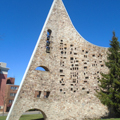By 1965, Grace Lutheran Church had outgrown its original quarters and commissioned Harold Wagoner, a prolific ecclesiastical architect from Philadelphia, to design what has become a local landmark. Sweeping skyward in a graceful curve, the main mass of the steelframe building is covered with randomly cut local stone that is pierced with many small, asymmetrically placed, geometrically patterned stained glass windows that subtly filter the light, as in Le Corbusier's Ronchamp of 1950–1955 in France. An arched opening in the wall houses three bells, and the arch motif repeats in the church's main entrance. Within the sanctuary, the sweeping, curved lines of the exterior define the main worship space, with high, open views in every direction. A freestanding circular altar and suspended cross complement the overall design. Grace Lutheran exemplifies both continuity and change, exhibiting the strong, relatively conservative Lutheran social base of this part of
You are here
Grace Lutheran Church
1965, Harold E. Wagoner. 205 S. Garner St.
If SAH Archipedia has been useful to you, please consider supporting it.
SAH Archipedia tells the story of the United States through its buildings, landscapes, and cities. This freely available resource empowers the public with authoritative knowledge that deepens their understanding and appreciation of the built environment. But the Society of Architectural Historians, which created SAH Archipedia with University of Virginia Press, needs your support to maintain the high-caliber research, writing, photography, cartography, editing, design, and programming that make SAH Archipedia a trusted online resource available to all who value the history of place, heritage tourism, and learning.





